Sip Champagne: A Ruinous Affair or Exquisite Delight?
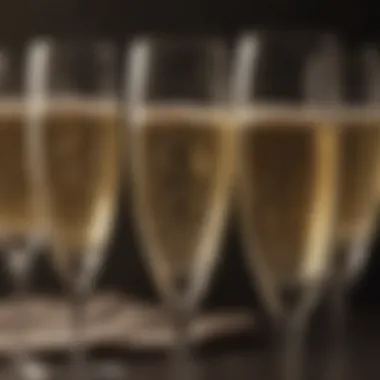
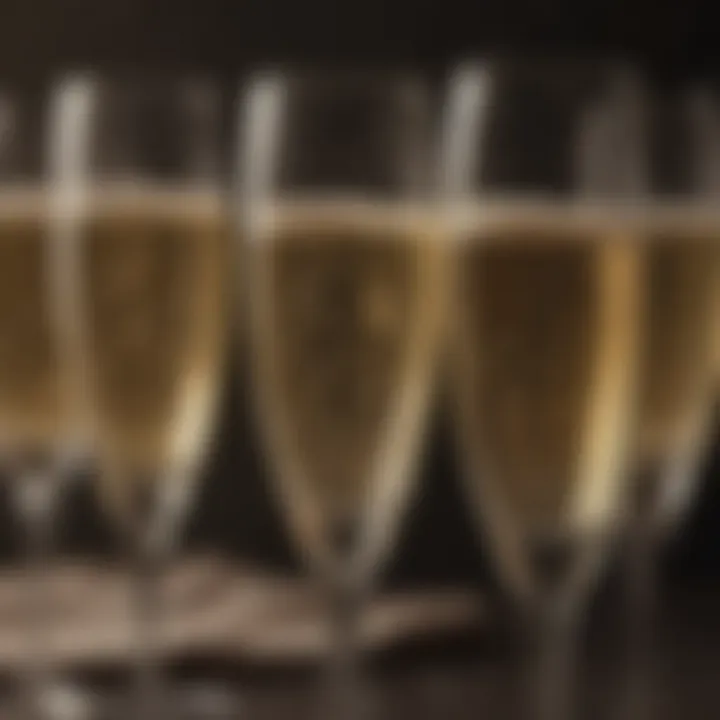
Intro
The consumption of champagne has long been revered and ritualized across many cultures. It possesses a unique position within our social fabric, often linked to moments of celebration and joy, yet also tied to somber occasions. The effervescent nature of champagne leads to questions about its place in our lives. Is it merely a luxury that contributes to financial ruin, or does it serve as a sublime accent to our most cherished memories?
To navigate these complexities, the following sections will delve into the historical significance of champagne, examine sensory experiences that accompany its sipping, and address cultural practices surrounding this beverage. Each aspect will illuminate the nuanced relationship between champagne and those who partake in it, offering insights into its critical role in both festive and melancholic moments.
By taking an analytical approach, this article aims to provide a clear understanding of the duality inherent in the world of champagne—defined by opulence and accessibility, celebration and commemoration.
Cultural Significance
Champagne has transitioned from being a rare indulgence to a symbol of achievement and community. In various ceremonies, its consumption signifies a collective joy or remembrance. Weddings, births, and milestones often evoke the pouring of champagne, marking the peaks of human experience. In contrast, during moments of loss, champagne can serve as a remembrance tool, allowing individuals to connect in reflection on shared memories.
The Anatomy of Taste
Tasting champagne requires an understanding of its composition and flavor profiles. The balance between sweetness and acidity plays a crucial role in defining a quality bottle. Distinct notes often emerge, ranging from fruity to nutty depending on fermentation and aging processes. Engaging with these flavors not only elevates the drinking experience but also deepens an appreciation for the craftsmanship involved in champagne production.
As we continue to explore these themes, we will uncover the rituals associated with champagne, both in revelry and mourning, the journey of winemaking, and how modern dynamics have altered its consumption. Each element sheds light on the intricate tapestry woven around this sparkling beverage.
Historical Context of Champagne
Understanding the historical context of champagne is crucial. It sheds light on its cultural significance and the evolution of its consumption. As a beverage, champagne transcends mere enjoyment, reflecting social dynamics throughout history. Historical narratives provide insight into the rituals surrounding champagne, its ties to celebrations, and even its role in mourning.
Origins of Champagne
The origins of champagne can be traced back to the Champagne region of France. This area is characterized by its unique climate and soil, making it ideal for grape cultivation. The region's most renowned grape varietals, such as Chardonnay, Pinot Noir, and Pinot Meunier, contribute significantly to the flavor profile of champagne.
In the early days, sparkling wines from this region were not well defined. The method of production was organic, and fermentation often occurred in bottles, leading to the bubbles that characterize champagne today. This accidental discovery cultivated a rich legacy, as wine producers refined their techniques over centuries. By the early 17th century, the deliberate crafting of sparkling champagne began, largely attributed to the efforts of winemakers like Dom Pérignon. His innovations in blending and aging laid the groundwork for the production techniques used still today.
Champagne in French Culture
Champagne holds a prestigious position within French culture. It is synonymous with celebration, luxury, and moments of joy. From royal ceremonies to everyday gatherings, the presence of champagne elevates occasions. The beverage evokes sentiments of happiness and festivity, serving as the backdrop for significant events such as weddings, anniversaries, and holidays. Its cultural relevance extends to art and literature, where it symbolizes indulgence and sophistication.
Moreover, champagne is deeply interwoven in the French economic fabric. The Champagne industry supports numerous jobs, from vineyard workers to marketing professionals. The commitment to quality production methods and adherence to strict regulations, such as the Appellation d'Origine Contrôlée, reinforce the cultural and national pride associated with this beverage.
Global Expansion of Champagne Consumption
Champagne's journey beyond France reflects its increasing global appeal. In the 19th century, the beverage began to capture the interest of international consumers. Factors including increased trade, the rise of the bourgeoisie, and the appeal of luxury goods contributed to this trend.
Today, champagne is recognized worldwide as a symbol of celebration. Markets have expanded significantly, driven by social media and globalization. Countries such as the United States, Japan, and China have adopted champagne as a staple in social events. The celebration of New Year's, for instance, often features champagne prominently in many parts of the world. This global consumption has led to a robust market that continues to evolve, with new brands and styles appearing regularly.
The Production of Champagne
The production of champagne is a multifaceted process that goes beyond mere fermentation. This segment delves into the intricate details of how quality champagne is created, from the environment it thrives in to the essential techniques used in its crafting. Understanding these elements is crucial for appreciating the value of champagne and its place within both cultural and personal celebrations.
Terroir and Its Impact
Terroir, a French term that encompasses the geography, geology, and climate of a specific region, is pivotal in champagne production. The Champagne region of France, with its unique combination of chalky soils and favorable microclimates, contributes significantly to the grape's characteristics. The limestone-rich soils drain well, allowing the roots of the vines to reach deep for nutrients. This specific connection between the land and the wine it produces defines the essence of champagne.
Whether it is the subtle nuances in flavor or the overall quality, the terroir plays a vital role in achieving the desired profile of champagne. Consequently, producers often emphasize the importance of origin, with many labeling their bottles with specific vineyard designations.
The Winemaking Process
The winemaking process of champagne is meticulous and requires great skill. Unlike standard wines, champagne undergoes a unique method known as méthode champenoise or traditional method. This process begins with the careful selection of grapes, predominantly Chardonnay, Pinot Noir, and Pinot Blanc. After harvesting, the grapes are pressed gently to extract the juice, which is then fermented.
The first fermentation takes place in stainless steel tanks or oak barrels, where sugars convert into alcohol. Following this, the blended wines undergo a secondary fermentation in the bottle, which is where the characteristic effervescence develops. This layered approach distinguishes champagne from other sparkling wines and enhances its complexity.
Aging and Secondary Fermentation
Aging is a critical component of champagne production. After the secondary fermentation, champagne is neutralized with sugar and yeast, known as dosage. This mixture adds sweetness and engages with the wine during aging. Legally, non-vintage champagne must be aged for a minimum of 15 months, while vintage champagne requires at least three years.
During this aging process, important chemical reactions occur. The yeast cells break down, releasing flavors and aromas that enrich the final product. The choice of aging duration and conditions significantly influences the champagne's taste, creating a diversity of styles suited to varying palates.
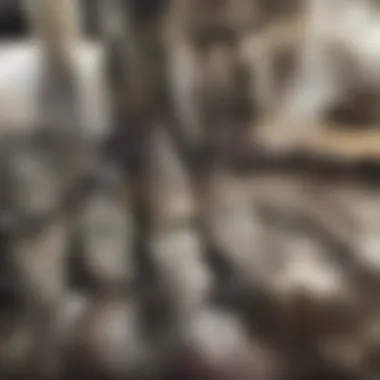
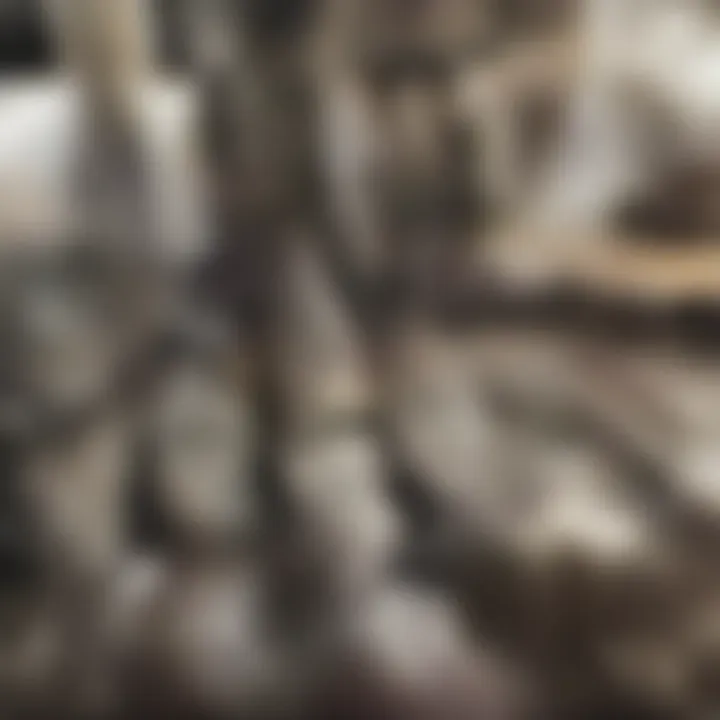
Champagne Varietals and Styles
Understanding champagne varietals and styles is crucial to navigating the complex world of this celebrated beverage. Beyond mere consumption, the distinction among various types of champagne showcases the depth of craftsmanship that goes into each bottle. The selection of grape varietals directly influences the flavor profile, aroma, and even the texture of the champagne. This section will delve into the types of grapes utilized in production, the different styles that emerge, and the significance of special editions and vintage offerings in creating a rich tapestry of champagne experiences.
Types of Grapes Used
The foundation of any quality champagne lies in the grapes used during production. There are three primary grape varietals that define the character of champagne: Pinot Noir, Pinot Meunier, and Chardonnay. Each of these grapes contributes distinct flavors and attributes to the final product.
- Pinot Noir is known for adding body and structure. It often provides notes of red fruits, such as cherry and raspberry.
- Pinot Meunier contributes freshness and fruitiness, often featuring hints of apple and peach. It complements the other varietals and adds a more approachable character.
- Chardonnay is prized for its elegance and finesse, delivering citrus flavors and hints of floral aromas. It is highly regarded in the production of vintage champagnes.
The blend of these grapes can vary significantly, allowing producers to create unique cuvées that reflect their style and the terroir of the vineyards. The interplay among these varietals showcases the nuance available in champagne production.
Different Styles of Champagne
Champagne is not monolithic. The diversity in production methods gives rise to several styles, each appealing to different palates. Here are some common styles:
- Non-Vintage (NV): This style comprises multiple years of harvest, delivering consistent taste and quality year after year. NV champagnes are often fruit-driven and accessible, making them popular choices for various occasions.
- Vintage: A vintage champagne is made from grapes harvested in a single year, indicating exceptional quality. Each vintage showcases the unique characteristics of that particular year, often resulting in more complex flavors and aromas.
- Blanc de Blancs: Made exclusively from Chardonnay, this style is typically light and refreshing with high acidity. It is perfect for those who appreciate elegance.
- Blanc de Noirs: This type is crafted from Pinot Noir and/or Pinot Meunier, yielding a fuller-bodied, robust profile. It often showcases darker fruit flavors and a rich mouthfeel.
- Rosé: Known for its pink hue, rosé champagnes are produced either by blending red and white wines or through skin contact with red grapes. They offer fruity notes and a refreshing quality that appeals to many drinkers.
The choice of style can enhance the drinking experience, making it essential for champagne enthusiasts to explore the various options available.
Special Editions and Vintage Offerings
Special editions and vintage offerings represent the pinnacle of champagne craftsmanship. These champagnes are often released in limited quantities, creating a significant buzz among collectors and connoisseurs alike.
- Limited Edition Releases: Many prestigious champagne houses produce limited runs of unique cuvées, often commemorating a milestone or event. These releases can offer exceptional taste experiences due to their rarity and distinct character.
- Vintage Offerings: Vintage champagnes often embody the best possible expression of a particular year’s harvest. They are aged longer than standard non-vintage options, leading to deeper complexity across flavor, aroma, and texture.
"Champagne, is the ideal drink for those celebrating the good moments and ones at the time of distress, serving as a testament to life's contrasting experiences."
In summary, the exploration of champagnes offers insight into how varietals and styles not only reflect the winemaker's intent but also shape the tasting experience. Familiarity with these aspects enhances appreciation and understanding of this storied drink.
Cultural Significance of Champagne
Champagne holds a unique place within social and cultural dynamics. This segment dives into various aspects of how champagne is woven into the fabric of human experiences. From joyous celebrations to solemn moments, the significance of this sparkling wine transcends mere taste. It serves as a centerpiece in both personal milestones and broader societal contexts, adjusting its role according to the occasion. Therefore, understanding its cultural relevance helps contextualize champagne beyond the aesthetic enjoyment of sipping.
Champagne in Celebrations
Celebrations are perhaps the most recognized domain for champagne. Its effervescence represents joy and festivity, making it a common choice for significant events like weddings, anniversaries, and New Year’s celebrations. Unlike other beverages, the act of popping a champagne cork is often a theatrical moment, symbolizing the beginning of a celebration.
- Pop and Fizz: The sound of a cork popping signifies the release of joy. It creates excitement, making the event more memorable.
- Ritualistic Pouring: The careful pouring into flutes further accentuates its special status. The bubbles rising bring a visual charm, reminiscent of the joyous occasion.
- Social Bonding: Sharing a glass of champagne can strengthen social ties. It acts as a conversation starter, fostering connections among guests.
This sparkling beverage not only marks memorable events; it also creates unforgettable experiences. Its consistent presence in celebrations reflects societal values surrounding festivity and unity.
Role in Mourning and Remembrance
Though often perceived as a celebratory drink, champagne also has a somber side. It plays a nuanced role in mourning and remembrance rituals. Sipping champagne in these contexts is more subdued but equally significant.
- Tributes: Often, champagne is used to toast the memory of those who have passed away. This act of remembrance transforms it into a symbolic gesture of honor and respect.
- The Balance of Life: Presenting champagne at memorial services can signify the balance between life and death. It serves as a reminder to celebrate the journey of the deceased while acknowledging their absence.
- Cultural Practices: In some cultures, it is customary to enjoy champagne during memorials. This act reflects the belief that the departed would want their loved ones to celebrate life.
Such practices reveal the intricate role champagne occupies in varying emotional landscapes, seamlessly transitioning from joyous moments to solemn commemorations.
Symbolism and Status
Beyond its taste and role in rituals, champagne is steeped in symbolism. It represents luxury, status, and sophistication, often associated with the affluent or upper classes.
- Social Climbing: Serving champagne at gatherings is a sign of prestige. It marks the occasion as exclusive and reflects the host's social standing.
- Household Names: Brands like Moët & Chandon or Dom Pérignon are synonymous with wealth, further embedding champagne in the culture of exclusivity.
- Fashion Statements: The choice to drink champagne is often linked to lifestyle branding. It triggers perceptions of elegance and gives insights into one’s identity.
"Champagne is the only wine that enhances a woman's beauty." — Louis Roederer
This symbolism can create a certain distance in social perception, implying that champagne is not merely a drink but a representation of one’s place in society.
The Experience of Sipping Champagne
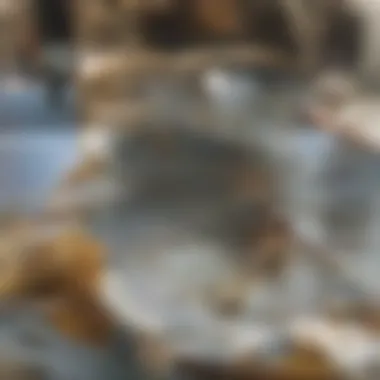
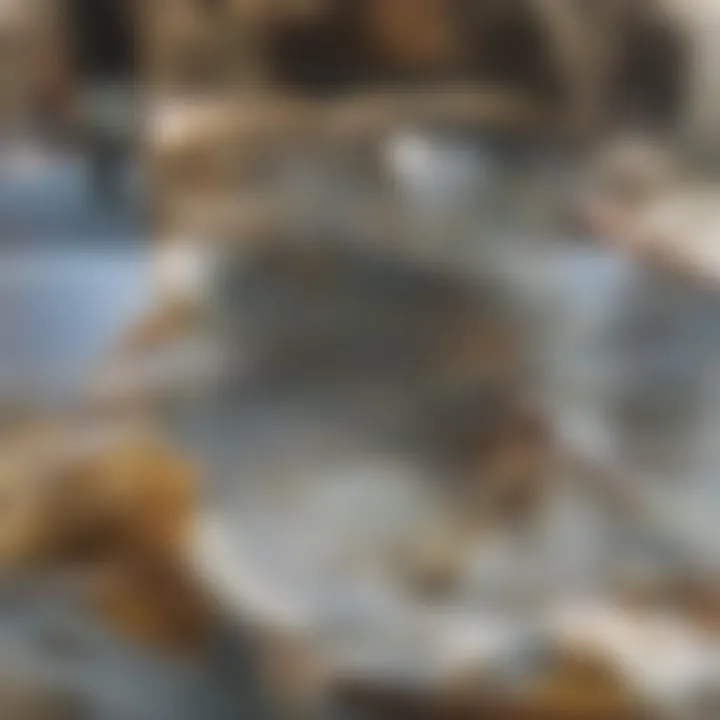
The act of sipping champagne is not merely about consuming a beverage; it is an experience steeped in tradition, ritual, and sensory delight. This section delves into the intricate layers that define this experience, including the tasting notes, the art of pairing champagne with food, as well as the nuances of glassware and pouring techniques. Understanding these elements enriches one's appreciation of champagne, transforming the act of drinking into a sophisticated endeavor.
Tasting Notes and Sensory Analysis
Tasting champagne involves more than just flavor. It engages all senses and is often described through sight, smell, taste, and even sound. When one pours champagne, observation starts with the effervescence. The bubbles rise gracefully in a glass, reflecting light and displaying a spectrum of golden hues, often indicating quality. Different champagnes present distinct aromatic profiles; one might note floral hints, orchard fruits, or even toasty brioche aromas. Classifying these sensory experiences helps one appreciate the intricacies of each varietal.
With tasting, it is crucial to focus on the interplay of sweetness, acidity, and body. Various styles, such as Brut or Demi-Sec, influence this experience. Resonance comes from the lingering finish, offering a glimpse into the wine’s complexity. This sensory analysis makes each sip captivating, fostering a deeper connection to the beverage and enhancing the enjoyment of significant moments.
Pairing Champagne with Food
Pairing champagne with food is an art that elevates both the beverage and the meal. The general guideline suggests that champagne, with its acidity and effervescence, can complement a wide range of dishes. For example, seafood, particularly oysters, is a traditional pairing that highlights the drink’s crispness. On the other hand, richer foods like poultry and creamy sauces can benefit from a fuller-bodied champagne.
Consideration should also be given to textures and intensities. Salty and bitter flavors, found in cheese or charcuterie, can resonate beautifully with the acidity of champagne. For dessert, sweeter champagnes or demi-sec styles can create lovely contrasts with pastries.
This versatility allows for creative combinations and personal preferences, ensuring that every dining experience is unique. Experimentation can lead to new discoveries, making each meal an opportunity to explore different regions and styles of champagne.
Glassware and Pouring Techniques
The choice of glassware plays a significant role in the overall experience of sipping champagne. Traditionally, flutes are preferred due to their tall and narrow shape, which helps retain the bubbles, though it may restrict the aroma. Tulip-shaped glasses, on the other hand, permit better aeration and aromatic experience while still showcasing the bubbles beautifully. Ultimately, the glass serves to enhance the tasting experience by concentrating the aromas and allowing for easier appreciation.
When it comes to pouring champagne, technique matters. It is often recommended to pour slowly down the side of the glass. This avoids excessive foaming, allowing the drink to maintain its effervescence. An optimal pour fills the glass to about two-thirds, leaving space for the aromas to develop and minimizing overflow.
In summary, the experience of sipping champagne goes beyond mere consumption; it involves a comprehensive engagement of the senses, intentional food pairing, and attention to glassware and pouring methods. Each aspect contributes to how champagne is perceived, enjoyed, and celebrated in various contexts.
Champagne in Popular Culture
Champagne holds a distinct and significant place in popular culture, acting as a symbol of celebration, luxury, and social prestige. Its portrayal in various artistic mediums amplifies its status and influences consumer behavior. This section delves into the nuances of how champagne is represented in film, literature, celebrity endorsements, and fashion.
Champagne in Film and Literature
Champagne often appears in films and literature as a representation of wealth and success. The iconic image of characters toasting with champagne glasses at grand events has become a staple in cinematic storytelling. For example, in The Great Gatsby, champagne is not only a drink but also a potent symbol of the opulence and excess of the 1920s. Such portrayals reinforce the association of champagne with high social status and glamorous lifestyles.
Literature, too, frequently highlights champagne in its narratives. Authors utilize champagne to evoke themes of celebration, romance, or even betrayal. It accentuates moments of high emotion or significant transitions in life. The choice of champagne in these contexts enhances the reader’s understanding of characters' motivations and the ambiance of the story.
Moreover, filmmakers and writers alike craft narratives that revolve around notable events involving champagne. Whether it's a wedding toast, a New Year's celebration, or a scene of high society, these moments solidify champagne's role as an emblem of festivity.
Celebrity Endorsements and Marketing
Celebrity endorsements play a critical role in shaping champagne's image in modern culture. High-profile figures, from film stars to athletes, often endorse specific brands, linking themselves to the elegance and sophistication associated with champagne. This creates a sense of desirability among consumers, who may aspire to live a lifestyle reminiscent of their idols.
Marketing campaigns frequently capitalize on this dynamic. Luxury brands like Moët & Chandon and Veuve Clicquot collaborate with celebrities to create exclusive events and advertisements. These campaigns not only elevate the brand's presence but also enable consumers to connect emotionally with the product. When a superstar is seen enjoying a champagne brand, it cultivates an impression of prestige.
Furthermore, the strategic placement of champagne in high-brow events—think film festivals or celebrity weddings—fuels its allure. The association of champagne with glamorous occasions solidifies its status as a premium product, further driving consumer interest.
Impact on Fashion and Lifestyle
Champagne's influence extends into the realm of fashion and lifestyle. It is often featured in high-fashion events, from runway shows to designer launches. The drink complements the aesthetics of exclusivity and refinement, lending a touch of elegance to these settings.
Fashion magazines frequently include champagne in their editorials, often depicting it alongside luxurious clothing and accessories. This connection enhances the perception of champagne as a lifestyle choice rather than just a beverage. It suggests that enjoying champagne is integral to a fashionable and sophisticated life.
In social contexts, those who indulge in champagne are often regarded as being socially elite. This perception can affect individuals' behavior, influencing how they choose to present themselves within their social circles. People are drawn to the lifestyle that champagne embodies, seeking to be associated with the glamour that it represents.
In summary, champagne's presence in popular culture—from film and literature to celebrity endorsements and fashion—cements its status as an icon of luxury. Understanding its role in these spheres reveals the complex relationship between consumption and identity, making it clear that sipping champagne is more than just about the drink; it is about the culture it embodies.
The Economics of Champagne
The economics surrounding champagne is most crucial to fully understand its standing in society. Champagne production is not just about making a beverage. It encompasses agricultural practices, market dynamics, and cultural perceptions. The cost of champagne can reflect the efforts of winemakers and the environment in which the grapes are grown. This section delves into the supply and demand dynamics, price influencers, and the pervasive issue of counterfeit champagne, shedding light on how these factors shape consumer experiences and market trends.
Supply and Demand Dynamics
Understanding supply and demand dynamics is essential for comprehending the market for champagne. The supply chain in champagne production is delicate and not easily scalable. A specific geographical region, namely the Champagne area in France, is protected by appellation regulations. As a result, the number of producers is limited. The unique terroir plays a vital role in the quality and character of the champagne, which further restricts mass production.
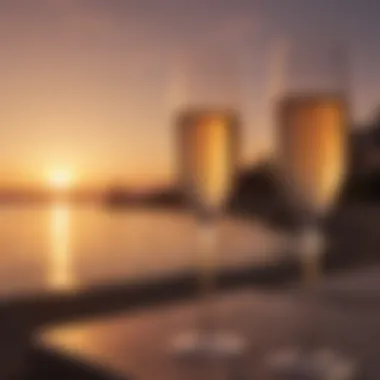
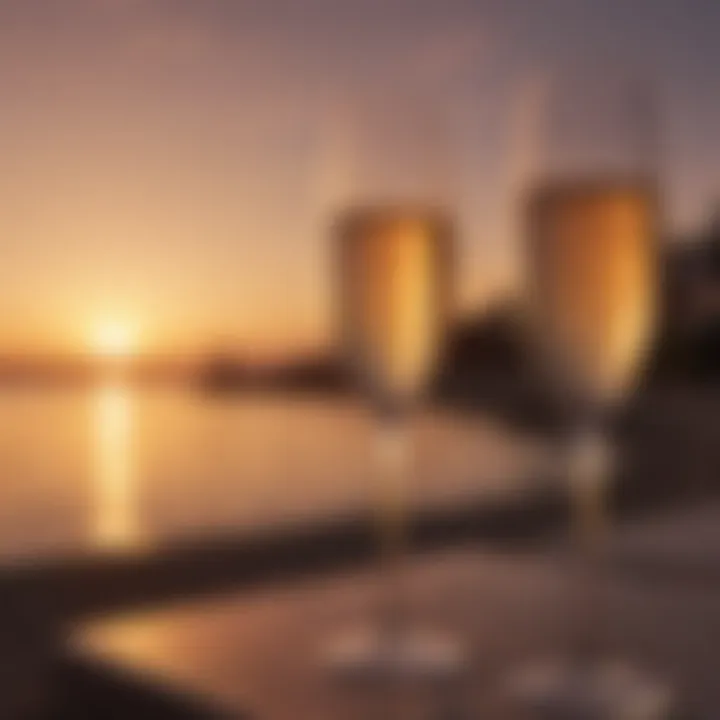
When demand rises, this can quickly outstrip supply. Following significant events such as holidays or weddings, there is typically an increased demand for champagne. This heightened interest often leads to price hikes. Consequently, any fluctuation in consumer tastes or trends can create an imbalance in the market.
Key Points on Supply and Demand:
- Limited geographical production areas.
- Demand spikes during festivities and celebrations.
- Potential for price fluctuations based on market behavior.
Price Influencers and Market Trends
The price of champagne is influenced by various factors. First, the intricacies of the winemaking process add significant costs. Labor-intensive methods such as manual harvesting and extended aging periods lead to higher production expenses. Furthermore, the reputation of a brand and the vintage year can significantly affect pricing.
Market trends also play a role. The growing interest in sustainable and biodynamic products has encouraged consumers to pay a premium for champagnes that align with those values. Additionally, changing demographics of consumers introduce new preferences that can shift trends in how champagne is viewed and purchased.
Quote: "The value of champagne is not just in its taste but in the experience it delivers—crafted through tradition, region, and modern influences."
Counterfeit Champagne and Authenticity
The rise of counterfeit champagne poses significant challenges for both consumers and authentic producers. As the demand heightens, so does the risk of encountering fake products. Counterfeit champagne can dilute the integrity of the luxury experience that genuine products provide.
Efforts to combat this issue focus on establishing strong brand identities and increasing consumer awareness regarding authenticity. Reliable producers often implement security features, such as unique labels or bottle codes, to ensure customers receive genuine champagne.
Considerations Regarding Authenticity:
- Awareness of brand and its characteristics.
- Importance of official retailers.
- Verification measures implemented by producers.
Sustainability in Champagne Production
Sustainability in champagne production is an increasingly pertinent issue, reflecting broader ecological concerns. As the world grapples with climate change and environmental degradation, the champagne industry must adapt to these challenges. Incorporating sustainable practices is not only beneficial for the environment but also for the reputation and longevity of the champagne producers themselves.
The benefits of sustainability in champagne production include a reduction in the carbon footprint, improved soil health, and better quality grapes. These practices ensure that vineyards can continue to thrive in the face of changing climatic conditions. Moreover, consumers are becoming more environmentally conscious, and many seek products that align with their values.
Considerations for sustainable practices in champagne production should include water management, waste reduction, and biodiversity conservation.
Impact of Climate Change
Climate change poses a significant threat to the champagne industry. Increased temperatures and unpredictable weather patterns can affect grape growing cycles, resulting in less predictable harvests. Early grape ripening can lead to altered flavor profiles and diminished quality.
Champagne producers are now facing the challenge of adapting their viticultural practices. This may involve selecting grape varieties that are more resilient to heat or experimenting with new planting strategies. The impact of these changes on traditional champagne standards presents a unique dilemma for producers.
Organic and Biodynamic Approaches
Organic and biodynamic farming practices are gaining traction within the champagne industry. Organic methods focus on avoiding synthetic fertilizers and pesticides, promoting natural growth instead. This approach enhances soil quality and promotes ecosystem balance.
Biodynamic farming, an extension of organic practices, goes a step further by factoring in lunar cycles and celestial influences. This method encourages a holistic view of vineyard health. Many producers have begun to adopt these methods, recognizing the potential for improved grape quality and sustainability.
Future of Champagne Production
Looking ahead, the future of champagne production will likely involve a blend of traditional practices and innovative sustainability measures. Increasing consumer demand for environmental responsibility will drive producers to prioritize sustainable methods.
Innovations in technology can also play a crucial role. Precision agriculture, which uses data and technology to optimize vineyard management, is on the rise. Implementing such techniques can improve yields while minimizing environmental impact.
Champagne production will continue to evolve as producers respond to the challenges presented by climate change and shifting market expectations. The commitment to sustainability may become not just an ethical choice but a necessity in ensuring the quality and prestige of champagne for future generations.
Concluding Thoughts on Champagne Culture
The discussion of champagne culture provides a unique lens through which we can examine societal values, celebrations, and personal experiences. Champagne has transitioned from a drink reserved for royalty to a symbol of modern festivities. Its versatility in social contexts speaks to both tradition and innovation. In this article, we delve into how these elements intersect to create a comprehensive narrative surrounding champagne.
Reflections on Personal Experience
Personal experiences with champagne vary widely. For some, it represents cherished memories—weddings, graduations, or other significant milestones. Each sip invokes nostalgia and a sense of belonging. From the crispness of a freshly poured glass to the celebratory clink of glasses, these moments enhance our connections with friends and family.
"Champagne is the only wine that leaves a woman beautiful after drinking it."
— J. J. Audubon
The sensory experience of sipping champagne can also vary significantly. Factors such as the type of champagne, serving temperature, and even the setting where it is consumed alter its perception. Additionally, personal preferences add layers to the experience. Whether someone enjoys the dry elegance of a Brut or the sweeter profile of a Demi-Sec, individual tastes shape these memorable occasions.
The Future of Champagne in Society
As we peer into the future, the dynamics surrounding champagne will likely continue to evolve. Awareness of sustainability and environmental impact is increasing among consumers. This shift may encourage producers to innovate in sustainable practices, leading to organic and biodynamic champagne options.
Moreover, trends indicate that champagne will maintain its status as a celebratory staple, yet may also find its place in casual dining experiences. The democratization of champagne, once solely associated with luxury, allows a broader audience to engage with this beverage.







